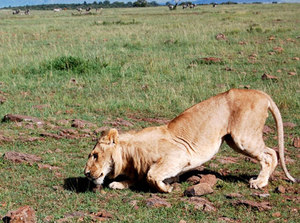
|
| ©WildlifeDirect
|
| A lion that ate a pesticide-laced hippo carcass stumbles in Masai Mara National Reserve in Kenya in this undated photo. Several hippopotamuses and at least four lions in the park have died after ingesting carbofuran, a powerful insecticide, conservationists say. Wildlife groups are concerned that pastoralists are increasingly using the compound to get rid of carnivores that prey on their livestock.
|
Several hippopotamuses and at least four lions in Kenya's famed Masai Mara National Reserve have died after ingesting a powerful insecticide, conservationists say.
The hippos ate grass contaminated by the pesticide, called carbofuran, and the lions became partially paralyzed after eating a hippo carcass, according to the conservation nonprofit WildlifeDirect.
The hippo carcass and one of the lions - which was euthanized - tested positive for the compound, the group said in a statement.
Conservationists are concerned that pastoralists are increasingly using carbofuran to get rid of carnivores that prey on their livestock.
(Related:
"Lions, Hyenas Poisoned in Ugandan Park" [August 20, 2007].)
"Incidences of poisoning represent a critical threat against Kenya's wildlife, particularly through the use of carbofuran," the group said.
Extreme ToxicityThe use of carbofuran is severely restricted in the United States and Europe because of its extreme toxicity to animals, which can mistake carbofuran granules for seeds.
Yet the pesticide, sold under the brand name Furadan, is cheap and widely available in Kenya.
Anecdotal evidence from WildlifeDirect suggests that carbofuran is used inappropriately in the country.
For example, the group says farmers use the compound on crops that are harvested after 30 days, though the pesticide is meant for crops that take 90 days or more to mature due to the health risks of overexposure.
The bottle labels also carry no warnings about human toxicity or usage procedures.
Short-term effects of exposure in humans include nausea, headache, weakness, and blurred vision, while long-term exposure can affect the nervous and reproductive systems.
The chemical has long been suspected in the killing off birds and other animals in Kenya.
One of the worst known carbofuran poisonings occurred in 2004, when 187 vultures and several hyenas were apparently killed by the pesticide.
"If you go to the market, you'll see the crops look beautiful," said Paula Kahumbu, head of conservation for WildlifeDirect.
"They have shiny green leaves, there's not a single mark, and this is a sign that the pesticides are very effective," Kahumbu said.
"It's so easily abused because education on it is very poor. They use it because it's effective; they don't really seem to realize that there are health concerns," she added.
UnjustifiedPhiladelphia-based FMC Corporation, the maker of carbofuran, denies WildlifeDirect's claims of inappropriate use, adding that the company cannot be held responsible.
The Kenyan distributor of Furadan, Juanco SPS, also denies that carbofuran caused the hippo deaths in Masai Mara.
"Those claims are completely unjustified, and we have our own data to support that," said Julius Gatembo, head of horticulture at Juanco.
"What they say about the hippos is just impossible. You'd probably require that hippo to eat about 300 to 500 [kilograms] [661 to 1,102 pounds] of Furadan at once to die from it.
"That's just impossible."FMC argued in 2006 that the U.S. Environmental Protection Agency had "exaggerated the risks of carbofuran and underestimated its unique benefits to agriculture."
The company added that carbofuran "does not pose an unreasonable risk" if handled correctly.
Greatest ThreatCarbofuran has increasingly been used in Kenya to kill predators such as lions and hyenas that prey on livestock, conservationists say.
Pastoralists, including the Masai, scatter carbofuran over their animals' carcasses. The lions that killed the animals come back to feed and later die.
"Livestock is absolutely everything to these pastoralists, and if something kills your favorite cow, you might not want to spend the time to send your son and his friends out to kill the animal," said Laurence Frank, director of the conservation group Living With Lions.
Poisoning is one of the greatest threats to Kenya's lions, Frank said.
No reliable census data of lions exist, but scientists have estimated about 2,000 animals remain - down from 10,000 in the 1970s.
Frank fears that some areas of the country could lose their already fragmented lion populations within five years.
(Related:
"Lion Killings Spur Fears of Regional Extinction in Kenya" [May 22, 2006].)
Carbofuran BanRichard Leakey, chair of WildlifeDirect and former head of Kenya's Wildlife Service, has called for a ban on carbofuran in Kenya.
But the likelihood of a ban seems slim.
The Agrochemicals Association of Kenya - which includes several chemical companies, including Juanco - is opposed to such a law.
Richard Sikuku, CEO of the association, refused to comment on the effects of carbofuran.
But he said he was furious about a recent meeting that Leakey convened to draw attention to the compound's ill effects.
"It's very unfortunate that people are talking about things that have not happened the way they say things have happened," Sikuku said.
Comment: Yes, it is. But it is also unfortunate that certain people accuse others of what they, themselves are doing.